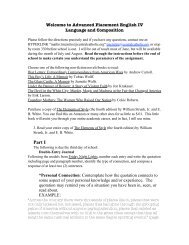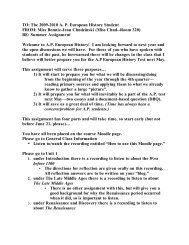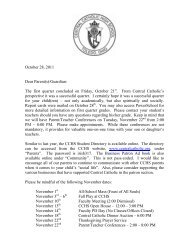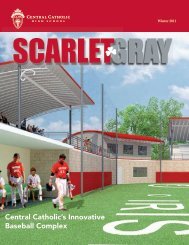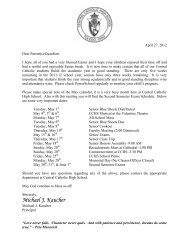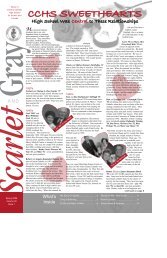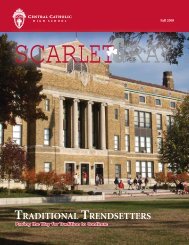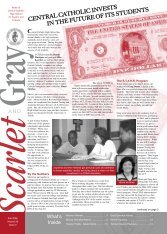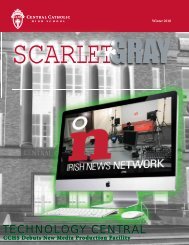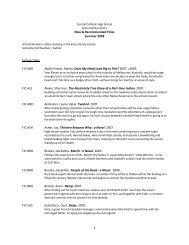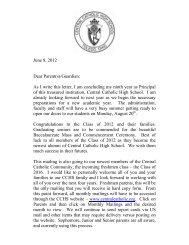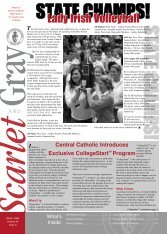Winter 2009 - K-Space Web Page - Central Catholic High School
Winter 2009 - K-Space Web Page - Central Catholic High School
Winter 2009 - K-Space Web Page - Central Catholic High School
You also want an ePaper? Increase the reach of your titles
YUMPU automatically turns print PDFs into web optimized ePapers that Google loves.
<strong>Central</strong> <strong>Catholic</strong> Classes<br />
Feature New Technology<br />
The <strong>Central</strong> <strong>Catholic</strong> art department recently<br />
purchased 12 Wacom Intuos3 Professional Pen<br />
Tablets for the graphic art classes. The students<br />
use these devices to quickly and professionally edit<br />
photos and create digital artwork and animation<br />
projects. They are used extensively for<br />
rotoscoping, an animation technique in which<br />
animators trace over live-action fi lm movement,<br />
frame by frame, for use in animated fi lms.<br />
The tablets come with an optical wireless mouse<br />
and a wireless pen that has 1,024 levels of tip and<br />
eraser pressure sensitivity. The harder the student<br />
presses, the darker or wider the media becomes,<br />
just like real artists’ media. It also has tilt<br />
sensitivity, which allows the pen to act just like an<br />
angled brush depending on how the students hold<br />
it. The tablet itself has express keys for keyboard<br />
shortcuts and a fi nger-sensitive touch strip for<br />
zooming in and out.<br />
Students in the science department also have<br />
access to some new technological tools. Thanks to<br />
a generous donation from a graduate, the<br />
department recently purchased a digital balance<br />
that measures to the thousandths place. Students<br />
can use the balance to fi nd the exact mass of an<br />
object and to measure exact amounts of small<br />
substances used in scientifi c experiments.<br />
Students have already used the balance to measure<br />
the content of water collected from the Maumee<br />
River in the annual Student Watershed Watch.<br />
The science department also has motion detectors<br />
to be used in the physics classes. The detectors can<br />
be linked to computers to plot continuous values<br />
of velocity versus time. Students can save the<br />
graph to Moodle, the CCHS course management<br />
system, and then analyze in detail the motion<br />
of objects.<br />
Mangas<br />
Family<br />
Concession<br />
Center<br />
In October, the concession<br />
stand in Gallagher Stadium<br />
was dedicated to the<br />
Mangas family for their<br />
generous support through<br />
the years.<br />
Teacher Participates in Summer Research Fellowship<br />
<strong>Central</strong> <strong>Catholic</strong> <strong>High</strong> <strong>School</strong> chemistry teacher Kathleen Wilkens was one of just eight<br />
chemistry teachers in the country chosen to participate in the fi rst annual Summer Research<br />
Fellowship program sponsored by the American Chemical Society. She worked full time<br />
for eight weeks at the University of Toledo with Dr. Terry Bigioni, a chemistry professor and<br />
research fellow at the university.<br />
The American Chemical Society is a nationwide professional organization for people who<br />
work in the chemical industry, and one of its missions is to improve chemistry education. The<br />
ACS decided to add a new program this year, the Summer Research Fellowship that would pay<br />
high school teachers to work over the summer in a chemistry research lab. Wilkens was chosen<br />
for one of the two positions available at the University of Toledo.<br />
“My goals in entering this program were to refresh my chemistry lab skills, learn about some<br />
cutting edge research from the ground level, make contacts at the chemistry department at the<br />
University of Toledo where some of my students subsequently attend college, learn how to use<br />
the latest types of research equipment like electron microscopes, and learn more basic<br />
chemistry,” Wilkens said. “It was a great experience and hard work!”<br />
Wilkens worked with Dr. Bigioni, who teaches chemistry and researches nanoparticles,<br />
thin-fi lm technology, and dye-sensitized solar cells. Nanotechnology is the study of small<br />
particles made up of relatively small numbers of atoms or molecules, and the topic is<br />
something Wilkens wanted to learn more about. “Scientists have discovered that when<br />
particles are nano-sized (nano means one billionth), they have very different properties than<br />
normal,” she explained. “For example, gold nanoparticles have different colors than gold as we<br />
normally see it. So if we can build materials from nanoparticles instead of taking materials as<br />
we fi nd them in nature, we can perhaps take advantage of new properties of those materials<br />
that we are just beginning to discover.”<br />
Wilkens also worked with the dye-sensitized solar cells and learned more about electrical<br />
circuits, nanoparticles, and how to use both conventional and cutting edge lab equipment.<br />
“I think anytime I can learn more about what I teach and also experience what people in the<br />
chemistry fi eld are<br />
doing, it<br />
contributes to my<br />
students’<br />
understanding of<br />
chemistry,” she said.<br />
“I have already talked<br />
a lot about my<br />
experiences this<br />
summer with my<br />
classes. I also got an<br />
opportunity to meet<br />
other researchers<br />
in nearby labs and<br />
learned about their<br />
research.”<br />
www.centralcatholic.org



